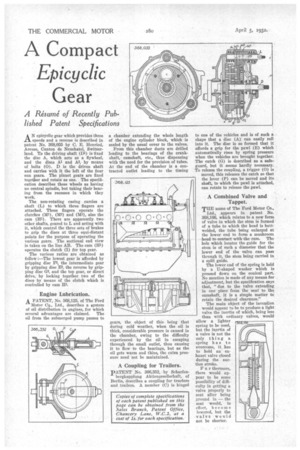A Compact
Page 70

If you've noticed an error in this article please click here to report it so we can fix it.
Epicy clic
Gear
A Resume' of Recently Published Patent Specifications
AN epicyclic gear which provides three speeds and a reverse is described in patent No. 368,055 by C. E. Henriod, Areuse, Canton de Neuchatel, Switzerland. To the driving shaft (DI) is fixed the disc A, which acts as a flywheel, and the discs Al and A2, by means of bolts (0). D is the driven shaft and carries with it the left of the four sun gears. The planet gears are fixed together and rotate as one. The specification describes these wheels as having no central spindle, but taking their bearing from the recesses in which they work.
The non-rotating casing carries a shaft (L) to which three fingers are attached. These fingers operate the clutches (Ml), (M2) and (M3), also the cam (Hi). There are apparently two other shafts, geared to L and acting with it, which control the three sets of brakes to grip the discs at three equi-distant points for the purpose of operating the various gears. The sectional end view is taken on the line AB. The cam (Hi) operates the clutch (I) for top gear.
The various ratios are obtained as follow :—The lowest gear is afforded by gripping disc F2, the intermediate gear by gripping disc E. the reverse by gripping disc G2, and the top gear, or direct drive, by locking together two of the discs by means of the clutch which is confrolled by cam Ht.
Engine Lubrication. A PATENT, No. 368,125, of The Ford Motor C9., Ltd., describes a system of oil distribution in engines, for which several advantages are claimed. The oil from the submerged pump passes to
a chamber extending the whole length of the engine cylinder block, which is sealed by the usual cover to the valves.
From this chamber ducts are drilled leading to the bearings of the crankshaft, camshaft, etc., thus dispensing with the need for the provision of tubes. At the end of the chamber is a contracted outlet leading to the timing gears, the object of this being that during cold weather, when the oil is thick, considerable pressure is caused in the chamber, owing to the difficulty experienced by the oil in escaping through the small outlet, thus causing it to flow to the bearings, but as the oil gets warm and thins, the extra pressure need not be maintained.
A Coupling for Trailers.
PATENT No. 366,352, by Scharfenbergkupplung Aktiengesellschaft, of Berlin, describes a coupling for tractors and trailers. A member (C) is hinged
to one of the vehicles and is of such a shape that a disc (A), can easily roll into it. The disc is so formed that it affords a grip for the pawl (E) which automatically rises by spring pressure when the vehicles are brought together. The catch (G) is described as a safeguard, but it seems hardly necessary. To release the coupling, a trigger (0) is moved, this releases the catch so that the lever (P) can be moved and its shaft, to which the pawl is attached, can rotate to release the pawl.
A Combined Valve and Tappet.
THE name of The Ford Motor Co.,
Ltd., appears in patent No. 368,166, which relates to a new form of valve in which the stem is formed of a tube to which the head is buttwelded, the tube being enlarged at the lower end to form a mushroom head to contact with the cam. The hole which locates the guide for the stem is of such a diameter that the lower end of the valve can pass through it, the stem being carried in a split guide.
The lower end of the spring is held by a U-shaped washer which is pressed down on the conical part. No mention is made of any means for adjustment, but the specification says that, "due to the valve extending In one piece from the seat to the camshaft, it is a simple matter to retain the desired clearance."
The main object of the invention would appear to be to produce a light valve the inertia of which, being less than with ordinary valves, would allow a lighter spring to be used, but the inertia of a valve is not the only thing a spring has to overcome, it has to hold an exhaust valve closed during the suction stroke.
P u r thermore, there would appear to be some possibility of difficulty in getting a valve properly to seat after being ground in — the scat would, in effect, become lowered, but the valve would not be shorter.












































































































